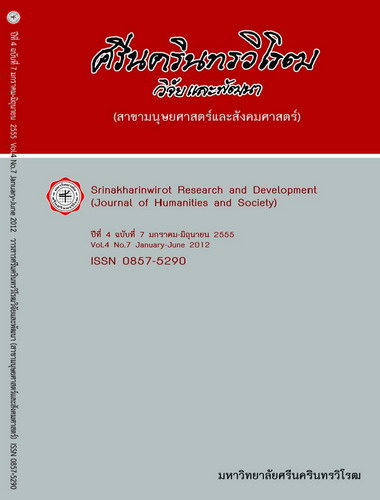การศึกษาผลสัมฤทธิ์ทางการเรียนสังคมศึกษา ศาสนา และวัฒนธรรม และความสามารถในการคิดแก้ปัญหา ของนักเรียนชั้นมัธยมศึกษาปีที่ 1 ที่ได้รับการจัดการเรียนรู้แบบซิปปา กับการจัดการเรียนรู้แบบอริยสัจสี่
Keywords:
Achievement, Solving problem, Cippa, Four noble truthsAbstract
บทคัดย่อ การศึกษาครั้งนี้มีความมุ่งหมายเพื่อการศึกษาผลสัมฤทธิ์ทางการเรียนสังคมศึกษา ศาสนาและวัฒนธรรม และความสามารถในการคิดแก้ปัญหา
ตัวอย่างเป็นนักเรียนชั้นมัธยมศึกษาปีที่ 1 โรงเรียนสาธิตมหาวิทยาลัยศรีนครินทรวิโรฒ ประสานมิตร (ฝ่ายมัธยม) ภาคเรียนที่ 2 ปีการศึกษา 2553 จำนวน 90 คน ได้จากวิธีการสุ่มแบบกลุ่ม (Cluster Random Sampling) 2 กลุ่ม กลุ่มละ 45 คน กลุ่มทดลองที่ 1 ได้รับการจัดการเรียนรู้แบบซิปปา และกลุ่มทดลองที่ 2 ได้รับการจัดการเรียนรู้แบบอริยสัจสี่ เวลาที่ใช้ในการทดลองกลุ่มละ 18 คาบ ตามแบบแผนการวิจัยแบบสุ่มกลุ่ม ทดสอบก่อน-หลัง (Randomized Control Group Pretest-Posttest Design) และวิเคราะห์ข้อมูลโดยใช้สถิติค่าที (t-test Independent sample และ t-test for dependent sample)
ผลการวิจัยพบว่า
1. นักเรียนที่ได้รับการจัดการเรียนรู้แบบซิปปา กับการจัดการเรียนรู้แบบอริยสัจสี่ มีผลสัมฤทธิ์ทางการเรียนสังคมศึกษา ศาสนาและวัฒนธรรม ไม่แตกต่างกัน
2. นักเรียนที่ได้รับการจัดการเรียนรู้แบบซิปปา มีผลสัมฤทธิ์ทางการเรียนสังคมศึกษา ศาสนาและวัฒนธรรม หลังเรียนสูงกว่าก่อนเรียนอย่างมีนัยสำคัญทางสถิติที่ระดับ 0.01
3. นักเรียนที่ได้รับการจัดการเรียนรู้แบบอริยสัจสี่ มีผลสัมฤทธิ์ทางการเรียนสังคมศึกษา ศาสนาและวัฒนธรรม หลังเรียนสูงกว่าก่อนเรียนอย่างมีนัยสำคัญทางสถิติที่ระดับ 0.01
4. นักเรียนที่ได้รับการจัดการเรียนรู้แบบซิปปา กับนักเรียนที่ได้รับการจัดการเรียนรู้แบบอริยสัจสี่ มีความสามารถในการคิดแก้ปัญหาไม่แตกต่างกัน
5. นักเรียนที่ได้รับการจัดการเรียนรู้แบบซิปปา มีความสามารถในการคิดแก้ปัญหา หลังเรียนสูงกว่าก่อนเรียนอย่างมีนัยสำคัญทางสถิติที่ระดับ 0.01
6. นักเรียนที่ได้รับการจัดการเรียนรู้แบบอริยสัจสี่ มีความสามารถในการคิดแก้ปัญหา หลังเรียนสูงกว่าก่อนเรียนอย่างมีนัยสำคัญทางสถิติที่ระดับ 0.01
Abstract
This research was to find the studying students achievement in social studies, religion and culture and ability in solving problem the instructional methods based on Cippa and Four noble truths. The samples of the study were 90 students of Mathayomsuksa I of Srinakharinwirot University Laboratory School during the second semester of the 2010 academic year. They were randomly selected by using cluster random sampling method and assigned into two experinented groups, with 45 students in each. The first experimental group was taught through learning using Cippa where as the second was taught through learning using Four noble truths. It took 18 teaching periods for each group. The research design of this study was Randomized group Pretest-Posttest. The t-test Independent sample and t-test for dependent sample (Different score) was used for data analysis.
The results of this study indicated that.
1. The students approached by Cippa model with four noble truths model had achievement on social studies, religion and culture was not different.
2. The students approached by Cippa model had their higher Post-Test achievement on social studies, religion and culture than pre-test criterion at the 0.01 level of significance.
3. The students approached by Four noble truths model had their higher Post-Test achievement on social studies, religion and culture than pre-test criterion at the 0.01 level of significance.
4. The students approached by Cippa model with Four noble truths model had problem solving ability was not different.
5. The students approached by Cippa model had problem solving ability higher Post-Test than pre-test criterion at the 0.01 level of significance.
6. The students approached by Four noble truths model had problem solving ability higher Post-Test than pre-test criterion at the 0.01 level of significance.
Downloads
Downloads
Published
How to Cite
Issue
Section
License
Srinakharinwirot Research and Development Journal of Humanities and Social Sciences is licensed Under a Creative Commons Attribution-NonCommercial-NoDerivs 4.0 International (CC-BY-NC-ND 4.0) License, Unless Otherwise Stated. Please Read Journal Policies Page for More Information on Open Access, Copyright and Permissions.


